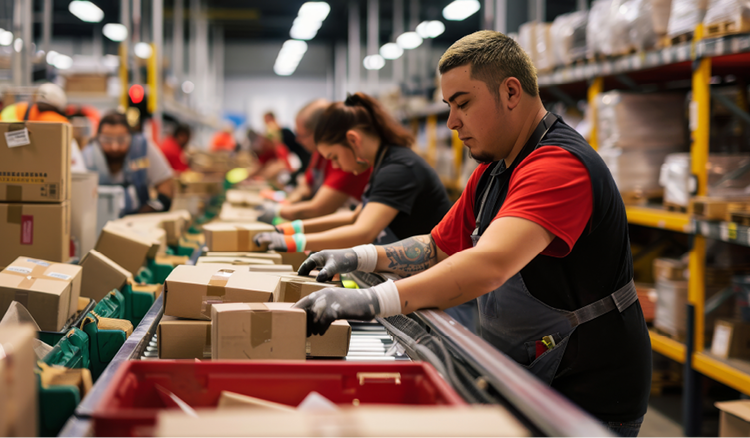Scaling For Peak Season: Why On-Demand Labor is a Game-Changer for E-Commerce, Logistics, and Packaging
As the holiday season approaches, e-commerce, logistics, and packaging companies face their biggest challenge: scaling operations to meet surging demand without breaking the bank. In 2024, peak season is expected to grow more modestly compared to previous years. According to the National Retail Federation (NRF), holiday retail sales are forecasted to increase by just 2.5% to 3.5% over 2023. With this slower growth and inflation pressures impacting consumer behavior, demand is becoming more unpredictable. For businesses navigating these complex dynamics, on-demand labor presents a powerful solution.
The Challenge of Peak Season in 2024
From inventory surges to last-minute orders, peak season remains a high-stakes period for e-commerce, logistics, and packaging. Traditional staffing models often lead to over-hiring, overtime expenses, and burnout among permanent employees. For instance, 90% of holiday shoppers this year report that inflation will impact their spending decisions, according to the International Council of Shopping Centers (ICSC). Shoppers are more price-sensitive, hunting for early deals and discounts, which can shift demand unexpectedly.
Many companies overstaff to prepare for these surges, paying for idle labor when the season cools down. Yet with increased price sensitivity and economic uncertainty, we’re seeing greater demand volatility as retailers race to meet customer needs with aggressive discounting strategies. For instance, even Walmart has slashed its Walmart Plus subscription price by 50% in an attempt to compete with Amazon during the holiday season. This illustrates the heightened competition and changing consumer dynamics. These fluctuations require flexible solutions that adjust with demand rather than relying on fixed, traditional staffing.
Why On-Demand Labor is Different
On-demand labor offers an efficient, flexible alternative for companies needing to stay agile in this volatile environment. By tapping into Veryable's nationwide network of 690k+ skilled workers only when needed, companies can avoid carrying the overhead costs of traditional hires while staying responsive. This approach lets businesses reduce reliance on overtime, minimize turnover risks, and adjust to real-time demand more effectively.
At Veryable, we empower businesses to create “Your Labor Pool” of qualified operators who return whenever needed, but who don’t add to fixed labor costs when they’re not in use. Our Workforce Management tool further enables precision labor planning by syncing directly with real-time demand from ERP and WMS systems.
Leveraging Peak Season to Drive Year-Round Performance
One of the unique advantages of Veryable’s on-demand labor model is that it’s designed to support companies beyond the peak season, turning a seasonal strategy into a year-round performance booster. By building a labor pool through Veryable, companies have access to skilled operators who can be called in to cover daily fluctuations, unexpected call-outs, or temporary staffing gaps without the burden of overhauling their workforce.
This approach mitigates the impact of turnover, addresses bottlenecks before they affect productivity, and allows companies to drive performance consistently. Unlike traditional seasonal programs that wind down in January, Veryable’s model allows businesses to leverage their peak season investment to maintain an adaptable, efficient workforce long after the holiday rush. With the ability to flex staffing as needed, companies can meet daily operational demands seamlessly, turning workforce flexibility into a sustainable competitive advantage.
The Benefits in Action
Here’s how on-demand labor is helping companies successfully navigate this unique 2024 peak season:
1. Cost Savings: Businesses save up to 30% on seasonal labor by staffing precisely when needed, allowing them to avoid the high costs of hiring full-time employees for short-term demand.
2. Flexibility: Real-time adjustments enable companies to increase or decrease their workforce daily, meeting demand fluctuations and controlling labor expenses without compromising service quality.
3. Reduced Turnover: On-demand labor minimizes the burnout and turnover associated with peak-season hiring, as operators work shifts that align with their availability.
4. Enhanced Service Levels: The right staffing levels help businesses meet their service promises, especially important when demand spikes unexpectedly due to early promotions or last-minute discounts.
Packaging
Packaging companies see demand spikes when customers increase their own production and fulfillment to meet seasonal needs. Traditionally, these companies ramp up hiring weeks in advance, onboarding temporary workers en masse to prepare for expected production peaks. However, this strategy comes with downsides: it locks companies into set labor costs and fixed schedules that can’t easily adapt to day-to-day variations in client orders. A slight decrease in demand means paying for idle workers, while an unexpected spike can leave the team short-staffed and struggling to meet orders on time.
With an on-demand labor model, packaging companies can bring in additional workers only when client orders rise and keep a core team lean during slower periods. For instance, if a packaging plant sees a 20% increase in demand from e-commerce and retail clients during early November, it can add workers for peak shifts and cut back on slower ones, maintaining productivity while controlling costs. As the season progresses, on-demand labor also allows for targeted hiring. When a particular packaging line (like gift box assembly or custom wrapping) faces sudden high-volume orders, the company can bring in skilled operators who are already trained and familiar with the work, avoiding delays and meeting client deadlines.
By using on-demand labor, businesses can avoid these staffing disruptions and preserve efficiency year-round, responding to each client’s unique demands without overextending resources or losing skilled workers.
E-commerce
E-commerce companies face some of the most intense holiday surges across industries, with demand spiking during major shopping events like Black Friday, Cyber Monday, and other holiday promotions. Traditionally, these companies prepare by hiring full-time seasonal workers in October or November, with a focus on stocking, packing, and shipping roles. However, this model can lead to inefficiencies; onboarding seasonal staff requires time and resources, and once peak order volumes level out post-holidays, companies often find themselves overstaffed, leading to higher payroll costs and layoffs. This fixed staffing approach also limits flexibility, leaving e-commerce businesses vulnerable to daily demand swings or unexpected order increases.
An on-demand labor model provides e-commerce companies with the agility to match staffing precisely with order volumes. For example, during Black Friday and Cyber Monday, a fulfillment center might see a threefold increase in orders compared to an average day. With on-demand labor, the company can bring in extra packers and shippers just for these days, eliminating the need for fixed staffing levels that don’t align with real-time demand. Moreover, if order volumes continue to climb throughout December, the business can adjust by scaling up labor weekly, ensuring they meet the influx efficiently and without overtime costs.
Compared to conventional hiring, on-demand labor offers a smoother, data-driven approach, helping e-commerce companies avoid excessive costs, improve fulfillment speed, and adapt staffing precisely to meet customer expectations at every point in the season.
Logistics
Logistics companies face the critical task of meeting tight deadlines and managing increased transportation and distribution demands during the holiday season. Traditionally, they prepare by bulk-hiring warehouse operators, driver helpers, and sorters weeks or even months in advance. This approach can lead to resource strains: not only does it tie up significant payroll funds in anticipation of a seasonal spike, but it also restricts companies’ ability to respond dynamically to unexpected increases or decreases in shipment volumes. Additionally, training a large group of new seasonal hires is time-intensive, often leaving temporary staff less prepared and affecting productivity.
With on-demand labor, logistics companies can be more agile in how they handle peak season. For example, if a regional warehouse sees a 40% rise in inbound shipments during December, on-demand labor enables the business to increase warehouse staff for crucial shifts, preventing bottlenecks and ensuring that packages move efficiently. Conversely, if demand dips unexpectedly (such as during off-peak days), the business can scale back immediately without incurring unnecessary labor costs.
This dynamic, scalable model helps logistics companies balance costs with productivity, offering a responsive alternative to the fixed, inflexible staffing strategies that often create financial and operational burdens during and after peak season.
Stay Competitive in a Volatile Season
With inflation driving unpredictable demand and slower growth expected this year, companies in packaging, e-commerce, and logistics need more agile strategies to avoid the costly mistakes of overstaffing or under-delivering. On-demand labor isn’t just a trend—it’s a necessity in today’s economic climate. As more companies prepare to face the season’s challenges, Veryable’s solutions provide the adaptability required to stay competitive.
Stories From The Real World
In this video, several different Veryable users share how a flexible capacity strategy has helped them take full advantage of peak season.
For more on-demand labor success stories, click here.
How Can I Deploy This NOW!?!?
Are you ready to deploy this strategy for the demands of peak season? Veryable's platform will allow you to gain the capacity you need immediately, often the same day.
To get started with on-demand labor, take 5 minutes to create your free business profile. Our team of experts will reach out shortly after to walk you through the process and ensure that your team is setup for success. If you need any assistance, please contact us.
To learn more about why Veryable is a game-changing solution for e-commerce, logistics, and packaging companies during peak season, check out our previous article:
Previous Posts
Takt Time: What It Is and Why It Matters for Production Planning
The Future of Manufacturing and Logistics
Create a free business profile today to explore our platform.






